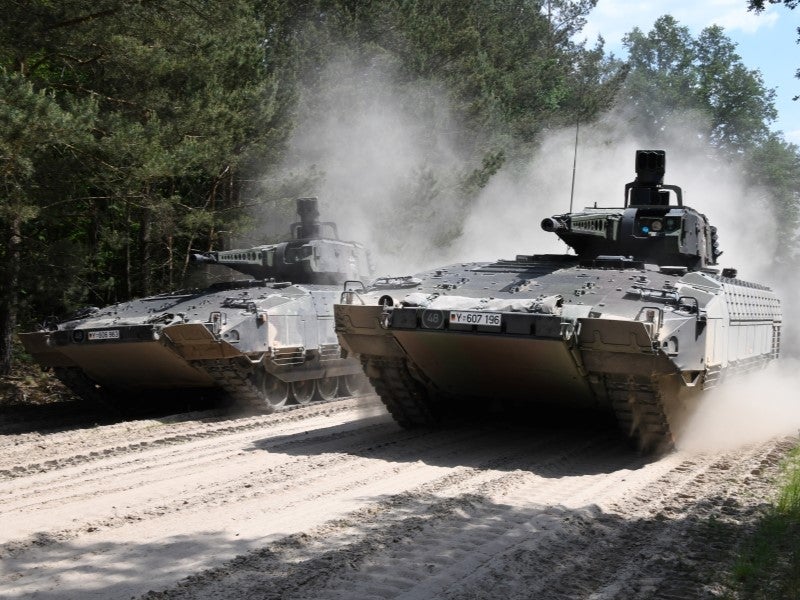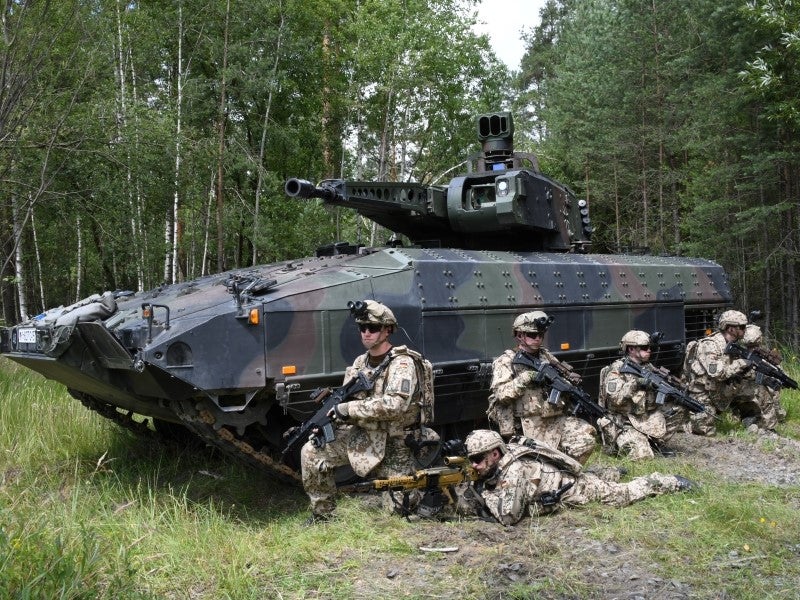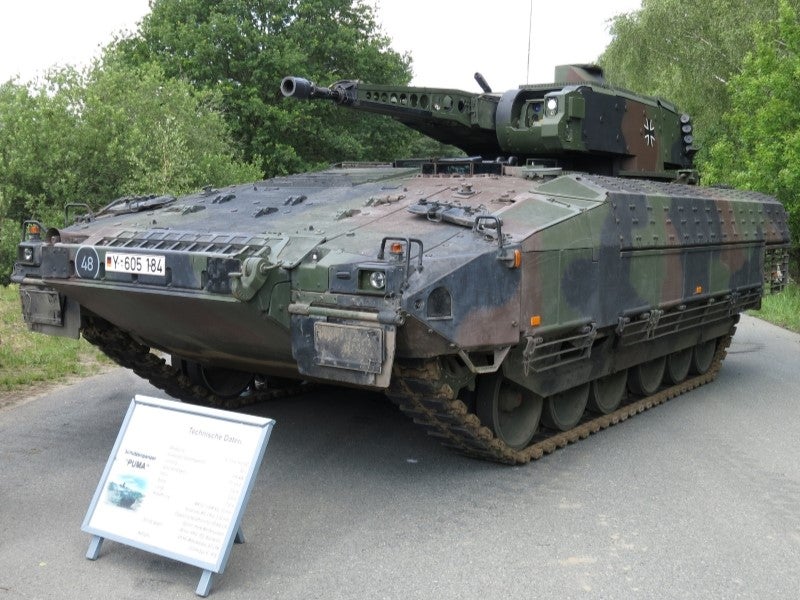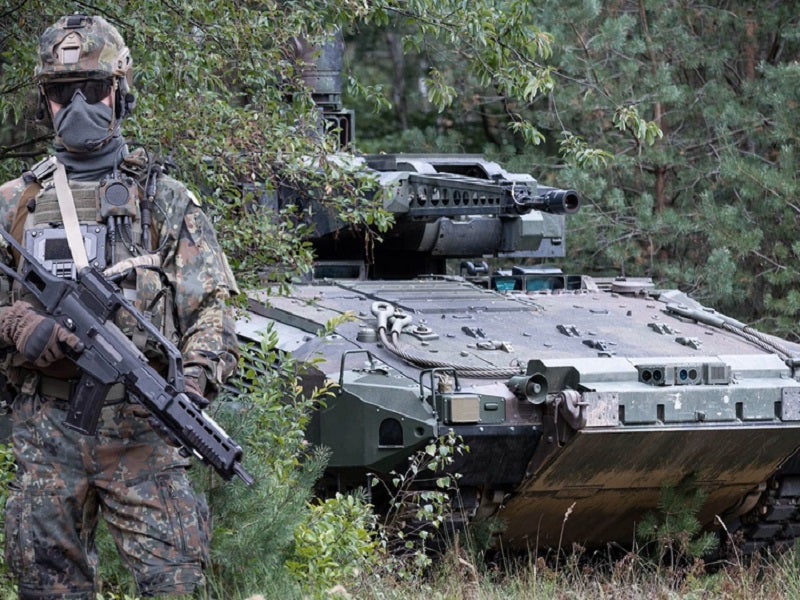The Puma armoured infantry fighting vehicle (AIFV) is a tracked vehicle manufactured by Projekt System & Management (PSM), a joint venture of German defence companies Rheinmetall Landsysteme and Krauss-Maffei Wegmann.
The vehicles are manufactured for the German Army under a programme authorised by the German Federal Parliament in 2002. The Puma programme was formerly known as the Igel and the Neuer Schuetzenpanzer (NsPz).
The AIFV is characterised by agility, firepower and ultimate crew protection on the battlefield.
Puma armoured infantry fighting vehicle design and features
The PUMA AIFV measures 7.4m in length and 3.7m in width. It has a turret roof height of 3.1m and weighs 31.4t for class A and 43t for class C.
The vehicle can carry nine crew members, including the vehicle commander, gunner and driver, as well as six infantry soldiers in the rear troop compartment. The Puma vehicles are designed to replace the Rheinmetall Landsysteme Marder 1 IFVs, which entered service in 1971 with the German Army.
Rheinmetall developed and designed the chassis. The vehicle has a modular construction, allowing it to be fully air transportable on an A400M aircraft.
The S1 standard vehicle is equipped with high-resolution day and night-capable camera systems, the MELLS multirole-capable lightweight guided missile system, and digital radio equipment.
Puma AIFV vehicle development
The Bundestag, the national parliament of Germany, approved the low-rate initial production of the first five vehicles in December 2004. The prototype vehicle and systems demonstrator was rolled out in December 2005 and delivered in May 2006.
Five pre-production vehicles were delivered in 2007, and army trials began in early 2008. In March 2009, the two pre-series Puma vehicles completed tests and trials at the German Army Training Centre.
In June 2009, the German parliament approved the procurement of 405 vehicles and a €3bn ($4.1bn) contract was awarded to PSM in July 2009. The first serial production Puma entered service in 2010. In March 2012, the IFV demonstrated its working capabilities under Arctic conditions at temperatures below -30°C at the subpolar proving ground in Norway.
The Puma AIFV completed its hot climate working trials in September and October of 2013. The Puma entered service with the German Armed Forces in April 2015 after passing rigorous tests and completing the final acceptance test.
The German army received its 100th Puma vehicle in December 2016. Rheinmetall completed the production of the 200th Puma AIFV and shipped it to the German Army in June 2018.
Puma IFV was declared combat-ready in March 2021.
Puma AIFV weapons
The vehicle is armed with a remotely controlled weapon station, developed by KMW, which is fitted with a dual-feed Mauser 30mm MK 30-2 automatic cannon. Rheinmetall is responsible for the integration of the Mauser cannon and the ammunition handling system.
The MK 30-2, which is in production for the Spanish Pizarro and Austrian Ulan IFV, has a rate of fire of 700 rounds a minute and a range of up to 3km.
The cannon fires 30mm APFSDS-T (armour-piercing fin-stabilised discarding sabot-tracer) rounds with a muzzle velocity of 1,385m/sec.
The rounds, developed by RWM Schweiz (formerly Oerlikon Contraves Pyrotec) and qualified in Switzerland for deployment in the Swiss and Austrian armed forces, entered volume production. The round is not fitted with a depleted uranium penetrator and is non-toxic.
The MK 30-2 cannon also fires the FAPIDS-T (frangible armour-piercing incendiary discarding sabot-tracer) round that is deployed against hard and soft targets.
A new round, the 30mm air burst munition by RWM Schweiz underwent qualification trials with the German Army and was fitted on the Puma IFV.
The ABM round (173mm long, 30mm diameter) contains an electronic timer, an ejection charge and 135 cylinder-shaped tungsten alloy bars or projectiles.
The MK30-2/ABM automatic cannon combines a high rate of fire with state-of-the-art ammunition technology. It has a maximum operating radius of more than 2,000m, making it highly effective against land, sea and aerial targets.
Eurospike is offering the Spike-LR fire-and-forget anti-tank missile for the German Army’s requirement for a guided missile system to arm the Puma armoured vehicle. In December 2008, a contract was signed between PSM and the German Ministry of Defence for the integration of the Spike missile system on Puma vehicles.
Self-protection and survivability
In August 2006, EADS Defence Electronics was awarded a contract for the multi-functional self-protection system (MUSS) for the Puma vehicles.
The MUSS can handle four threats simultaneously and is effective in 360° azimuth and 70° elevation.
The crew compartment has a fire suppression system, while the engine compartment is equipped with a fire extinguishing system.
The Puma AIFV has a nuclear, biological and chemical combined protection system and sensors for impending attack warnings.
Puma engine
The vehicle is fitted with a new high-power density 892 series diesel engine developed by MTU. The MTU 892 series is rated at 800kW, which provides the Puma with a power-to-weight ratio of 25.4kW/t.
The running gear is decoupled so the vehicle has low noise and vibration characteristics. KMW is responsible for the vehicle’s hydropneumatic suspension system. Diehl was selected to supply the tracks.
Battlefield management system
In April 2008, the German Defence Procurement Office awarded a contract to PSM for the integration of battlefield management systems on the Puma. The system integration brings network-enabled capability to the vehicle.
Armour variants
The Puma vehicle is built with the option of three levels of protection to suit the operational requirements. The versions weigh 29.4t, 31.45t and 43t.
The basic level 1, 29.4t, version protects from explosively formed projectile mines and top attack artillery projectiles, and offers all-round protection against 14.5mm kinetic energy rounds and RPG-7 rocket-propelled grenades.
The front and flank of the vehicle are fitted with a higher level of protection against 30mm kinetic energy rounds.
Level A was selected as the baseline armour protection for the Puma IFV for the German Army.
Level A gives all-round protection against 14.5mm machine gun rounds and artillery fragments. The front and flank are protected against 30mm cannon rounds. The front armour protects the crew from hollow charge rounds. The vehicle is also protected against 10kg blast and explosively formed penetrator mines. The German Army Puma with level A protection has a combat weight of 31.45t and is air transportable by the A400M aircraft.
Additional armour modules can be fitted to the hull and turret to provide level C protection. With level C armour protection, the combat weight is increased to 43t. It would be necessary to deploy four A400M transporters to carry three Puma IFVs fitted with level C armour protection, the fourth aircraft lifting the additional modular armour fits.
Puma AIFV orders
PSM received four contracts worth £370m ($422.5m) from Germany’s Federal Office of Bundeswehr Equipment, Information Technology and In-Service Support (BAAINBw) to modernise the Puma AIFV in July 2017.
The contracts covered the installation of advanced visualisation and display technology, the development of a new turret-independent weapon system, logistics and training for the MUSS, and the supply of 11 more turret trainers, along with the upgrade of the existing trainer.
In July 2019, contracts were signed between the Rheinmetall-KMW consortium and the German Bundeswehr to upgrade the Puma AIFV under the System Panzergrenadier VJTF 2023 project.
This project is intended to integrate the Puma vehicle into the German Army’s Future Soldier–Expanded System (IdZ-ES) soldier system in a networked combat environment.
Rheinmetall received an order worth €54m ($60.1m) in January 2020 to supply additional equipment for the Bundeswehr’s Puma IFV.
PSM signed a contract worth more than €1bn ($1.19bn) with the German Bundeswehr in June 2021 for upgrading 154 Puma AIFVs in service. The contractual scope also includes logistic services and additional capability upgrades.
The vehicles were upgraded in terms of core capabilities by retrofitting them with equipment that was tested using 40 Puma test vehicles. The 40 tested Puma AIFVs were deployed to the NATO Very High Readiness Joint Task Force (VJTF) rapid response force in 2023.
The contract also included options worth €820m ($978.67m) to upgrade the remaining 143 Puma AIFVs by 2029. The Bundeswehr exercised the option to retrofit the remaining 143 vehicles in April 2023.
In December 2022, Rheinmetall signed a framework contract worth €576m ($611.5m) with the Bundeswehr to deliver more than 600,000 rounds of medium-calibre ammunition for the Puma IFV. The company produces two main types of 30mm x 173 calibre service ammunition for the vehicle, namely the KE-TF DM21 and KE DM33.
KMW and Rheinmetall received another order worth €1.09bn ($1.1bn) to deliver 50 additional Puma vehicles to the Bundeswehr in May 2023.
In January 2024, Rheinmetall was awarded a €350m ($381.27m) contract for producing and delivering medium-calibre ammunition for the Puma vehicles. The contract falls under a pre-existing framework agreement that includes several hundred thousand rounds of 30mm x 173 DM21 service ammunition.
Rheinmetall will commence delivery of the ammunition after a successful demonstration of its functionality, with the delivery schedule extending from 2024 to 2027.







